JAXA Astronaut Activity Report, May, 2013
Last Updated: July 29, 2013
This is JAXA's Japanese astronaut primary activity report for May, 2013.
Astronaut Koichi Wakata joins 35S prime crew as its backup crew member
Astronaut Koichi Wakata had been assigned as a backup crew member for the Soyuz TMA-09M spacecraft (35S) and acted alongside the primary crew right up until the launch on May 29.
Completing all the training at the Gagarin Cosmonaut Training Center (GCTC) in Russia and participating in the traditional preflight ceremony in Moscow; on May 16, the 35S prime and the backup crews moved to the Baikonur Cosmodrome in Kazakhstan where the launch pad for the Soyuz spacecraft, is located. In addition, they had a medical checkup and were trained to adapt to weightlessness.
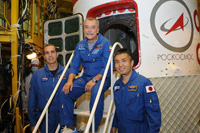
Wakata and other backup crew members pose for a commemorative photo in front of the actual Soyuz spacecraft (Credit: S.P.Korolev RSC Energia)
At the Baikonur Cosmodrome, the crews confirmed each procedure for the launch, rendezvous, and emergency landing with the GCTC instructors and flight controllers from Moscow as well as receiving the latest status of the ISS systems. They also confirmed the systems of the real Soyuz spacecraft and its cargo, which was in the process of being outfitted. In support of Wakata, astronaut Kimiya Yui had come to the site representing JAXA, to act as a liaison between Japan.
As planned, the Soyuz TMA-09M spacecraft carrying the 35S crew successfully lifted off on May 29. Thus Wakata's duty as a backup crew member was completed.
Astronaut Kimiya Yui's training for a long-duration ISS mission
Astronaut Kimiya Yui, assigned as a crew member for the ISS Expedition 44/45 mission, continues training for his upcoming mission.
From early to mid May, Yui received training at the Johnson Space Center (JSC) on the operation of the ISS, focusing on the Environment Control and Life Support System (ECLSS).
ECLSS is an indispensable system for astronauts to live on the ISS, adjusts temperature and humidity as well as circulates breathable air and recycles water. Through lectures, Yui became familiar with the ECLSS system and practiced how to maintain it following the operational procedure actually used on the ISS.
Other than the ECLSS, he was trained regarding the ISS Command and Data Handling (C&DH) system, Communication and Tracking System (C&TS), and Thermal Control System (TCS).
Meanwhile, he continued studying English and Russian.
Astronaut Takuya Onishi receives training on the Columbus at the ESA
From May 13-17, astronaut Takuya Onishi was trained for the Columbus laboratory module of the ISS, developed by the European Space Agency (ESA) at its European Astronaut Centre (EAC), located in Cologne, Germany.
Through lectures and using a mockup (a full-scale training facility), Onishi deepened his understanding of the systems of Columbus and the experiment hardware.
He received a lecture on the overall Columbus system and the operation of the laptop computer that provides an interface to monitor and control the systems, and then followed up by learning each system to gain a user level knowledge. In the latter half of the training, he practiced how to respond to emergencies.
Onishi got an overview of and learned each configuration and operation of the experiment hardware, including the Biolab, European Physiology Modules (EPM), Fluid Science Laboratory (FSL), and European Drawer Rack (EDR).
Astronaut Onishi experiences leadership training in the U.S.
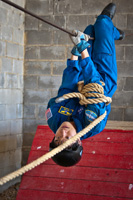
U.S. Onishi participating in the training (Credit: Air Force photo/Donna Burnett)
For two days from May 22, astronaut Onishi along with some NASA astronauts experienced leadership training held by the USAF Air University in the Maxwell Air Force Base in Alabama, U.S.
Participation in this training was intended to foster leadership skill and was to assess if this training could be beneficial for astronauts' NASA training in the future.
After the training, Onishi commented this way, "I found it very useful for improving leadership, followership, and unifying a team. Through the first few tasks, we were able to build trust in our teammates."
Astronaut Soichi Noguchi participated in a Japan-Italy cooperative event
On May 15, a Japan-Italy cooperative event "Japan and Italy: Space Cooperation Forefront" was held at the Agnelli Hall of the Instituto Italiano di Cultura, in Chiyoda-ku, Tokyo, and astronaut Soichi Noguchi participated in the event representing JAXA astronauts.
This was held as a part of the science and technology field among a series of "Italy in Japan 2013," events, hosted by the Italian Embassy.
In the first half of the event, cooperation between Japan and Italy in the field of space development was introduced. Among their cooperation, cosmic ray observation equipment CALorimetric Electron Telescope (CALET), now being developed, was introduced as representative of their cooperative activities. Professor Shoji Torii of Waseda University, the Principal Investigator (PI) of an experiment using CALET, made a presentation.
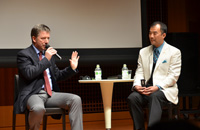
A talk session (Credit: JAXA)
In the last half of the event, a talk session was held entitled "Space activities from the viewpoint of astronauts- Based on experience on the ISS, and considering the future of manned space activities -." Noguchi appeared together with Italian astronaut Roberto Vittori to discuss the theme.
Noguchi introduced the relationship with Italy, including that Italy produces many astronauts and his training experience held in Italy. Noguchi also mentioned that soon after the Great East Japan Earthquake was occur, the crew on the ISS including an Italian astronaut made a cooperative action such as taking photos to grasp the situation.
This event became a valuable one as space development facts and Italy and Japan's international cooperation in the field of space development, not so well known in Japan, were introduced.
Astronaut Akihiko Hoshide restarts flight training using a T-38 jet trainer in US
Astronaut Akihiko Hoshide had been busy with postflight debriefing and giving lectures, as well as courtesy calls to related parties. However, from May, he returned to his flight training aboard T-38 jet trainer in the U.S., as one of the astronauts' training in preparation for a space flight.
In this flight training session, two people board the jet trainer aircraft and maneuver the aircraft while communicating with the ground and operating hardware, which at the same time requires decision-making ability and teamwork in varying situations.
Hoshide will continue this flight training as NASA requires astronauts to continuously receive flight training.
New Astronauts at the Front-Line

This month I was able to observe the Soyuz launch for which astronaut Wakata was appointed as back-up crew. This time my primary mission was to participate in essential meetings in Baikonur and to report the results of these back to Japan.
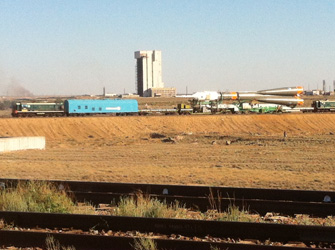
This month I was able to observe the Soyuz launch for which astronaut Wakata was appointed as back-up crew. This time my primary mission was to participate in essential meetings in Baikonur and to report the results of these back to Japan.
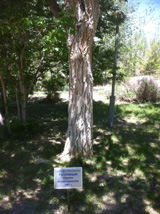
Baikonur is packed with the history of Russian space development and there are many places that should be visited! In Russia, there is a tradition of planting a tree to commemorate each space flight. This is Gagarin’s tree. It is very big and you can feel the history behind it!
I wonder if you have heard of a back-up crew before. As you can imagine from the name, it is a reserve crew of astronauts who can replace the prime crew (the astronauts originally selected for the flight) if they can no longer participate for some reason or other. So the back-up crew had to go through the same training and tests as the prime crew right up to the launch and so that they didn’t get ill or anything, they stayed in a different hotel to us in Baikonur and were isolated from the general public. Even though they are the back-up crew, there is the very real possibility that these astronauts will actually have to fly so they must, as a matter of course, maintain a perfect state of preparation, including mental preparation, just in case. Meanwhile, it is naturally the prime crew that gets all the attention at press conferences and so on ? the back-up crew really does play the important role of a team working behind the scenes.
In my previous job, I was a member of the Japan Self-Defense Force, in fact, I was a pilot, so this concept of back-up (reserve) has become indelibly ingrained in the innermost depths of my mind. I have got to the stage that if I don’t have a back-up, I feel nervous whatever I am doing!
For example, even when I go on business trips, I take spare money on top of the money that I expect that I will actually need and this spare money that I take is in various currencies. Aircraft flight control systems have separate back-up systems from the main system and it is normal to prepare reserves when planning military operations. Moreover, even when I am going to meet someone nearby, I factor in extra time so I always end up being early for appointments! When I have to leave my house together with my family, we are hardly ever able to leave at the time that I would like because everyone takes so long to get ready so I sometimes tell them that the planned departure time is 30 minutes earlier than the actual departure time. (For example, if I want to leave at 7 am, I tell them that we are leaving at 6:30.) When I do that, my wife says, ‘Sorry we are late in leaving. It took a while to get ready.’ And then I think, ‘Just as I thought.’ But I am able to be kind and say, ‘It’s OK. It’s hard work getting everything ready.’
In actual fact, the importance of back-ups in the world of space development is the same and all important functions and devices must have back-ups so that even if something that you don’t want to happen does happen, there is preparation in advance that enables you to maintain safety. However, preparing back-ups is all very well and good but that takes both money and effort and it doesn’t mean that we should have loads of back-ups for absolutely everything. There’s no point in spending too much money on the back-up and neglecting the main thing. The usual way to achieve the balance in preparation is to think about both the possibility of a situation occurring and the severity of this situation. Even if there is only a slight possibility of something occurring, it is essential to properly prepare in situations that could be potentially life threatening and even if the frequency is high, if there is no great influence on safety or execution of duties, there is no need to go to the trouble of creating a back-up. (For example, when you think about running out of petrol, which happens from time to time, there is no reason to have a spare petrol tank if you only drive in town. However, if you are going to be driving in the desert or in mountainous areas, a lack of spare fuel could be the difference between life and death, couldn’t it?)
In reality, in order to specifically consider when and how much back-up to prepare, it is necessary to analyse foreseeable situations in detail which is pretty difficult. I think a lot of readers will probably have been given advice from local governments on preparing reserves of food and other necessities in case of an earthquake but there are pre-requisite conditions when creating these criteria and it is hard work analysing these.
In reality, in order to specifically consider when and how much back-up to prepare, it is necessary to analyse foreseeable situations in detail which is pretty difficult. I think a lot of readers will probably have been given advice from local governments on preparing reserves of food and other necessities in case of an earthquake but there are pre-requisite conditions when creating these criteria and it is hard work analysing these.
Why don’t you try applying the concept of back-up to your everyday lives or to your work? You might reduce the amount of mistakes made at work and increase reliability and you may even obtain a bit of breathing room.
*Photo supplied by: JAXA

On a day in June when the heat wave had already started, I was looking through previous articles and pondering what I would write for this month’s New Astronaut at the Frontline.
I was reading our three articles from last month and then I suddenly thought.
Mr Yui was talking passionately about the meaning of happiness in life while on the other hand, Mr Kanai was telling us about the professionalism of controllers on the ground, citing the ten lessons from Gene Kranz but the main topic of my column was ‘breaking wind in space…’
This is not good. If I continue like this, people will misunderstand my character completely.
So, this month I am going to try to write about something a little more serious ? emergency situations on the International Space Station.
The ISS is a huge spacecraft and is composed of lots of sections, machines, equipment and computers and so on. And just outside the walls of the astronauts’ living area, separated only by one partition, is the great expanse of space where the human body cannot survive. In addition, it is at an altitude of around 400km above the earth and the thick wall of the atmosphere stretches out between the ISS and the earth where we live so astronauts require special technology and spacecraft to be able to return home.
This huge system has been built by humans. Of course, these systems are the same as most other ones on earth and are not completely immune to breakdowns or malfunctions. In actual fact, the ISS has had a number of problems, including minor malfunctions, up until now and on these occasions, the team on the ground and the astronauts worked together to find a solution. The most recent one I can remember is when, last year, one of the distribution devices for the station’s four electrical systems broke down and astronaut Hoshide did some extravehicular activity to replace the device.
There are many different kinds of malfunctions and breakdowns. There are breakdowns such as the example of the distribution device above that have a widespread effect on the operation of the station but there are also little things like electric lamps going out in the living area. There are four different degrees of severity for emergencies on the station and there are different ways of handling these depending on the degree. These are technical terms but the four degrees of severity for emergencies are, in descending order, Emergency ⇒ Warning ⇒ Caution ⇒ Advisory.
The most severe degree of 『Emergency』means a state of emergency and the definition this is: ‘state in which an appropriate response must be made immediately or there will be a danger to the lives of the astronauts.’
So what kind of thing actually constitutes an 『Emergency』?
There are three cases on the International Space Station that come under this category. I have given a simple explanation of these below.
①Fire
As there is no place to escape to outside the space station, fires are at least as dangerous as on earth, if not more so. If, by any chance, a fire occurs on the ISS, the astronauts proactively turn their hands to prompt fire-fighting activities. In order to do that, there are fire extinguishers installed all around the station and there are fire detection sensors all over the place so there is a system that sets off alarms as soon as a fire occurs.
And as a fundamental countermeasure, basically everything on the space station is either inflammable or flame resistant.
②Explosive Decompression (Air Leakage)
Explosive decompression is a technical term but it basically means that the air from the station leaks out into space. If this is neglected, the living area will also become a vacuum so this is also a very dangerous situation. These situations are dealt with on a case-by-case basis. Depending on the speed at which the air is leaking and the location of the hole that is the source of the leak, the optimum method for dealing with the leak is selected each time it happens.
For example, in cases in which the air is leaking at high speed and there is no time to stop up the hole, the section itself is isolated in order to protect the spread of any damage to other sections of the station. To liken it to a house, it is like closing all the doors of the room where the air leak has occurred and not going back into that room and this prevents other rooms from having air leaks.
③Occurrence of Toxic Substances
As you can’t even use the most basic and simple method of opening a window to ventilate like we do on earth, this is a really big problem. It is essential to contain the toxic substance immediately but if it is a gas, this is extremely difficult. Moreover, in space liquids scatter in all directions so this is not easy either. In the same way as the countermeasures for fires, basic measures are that there are protective masks all over the station and that everyone has to take refuge in a safe area for the time being, avoiding the occurrence of the toxic substance.
In a worst case scenario, the entire contamined section may have to be isolated.
The three situations above are the current definitions of states of emergency on the International Space Station. If you tried to imagine these situations, wouldn’t you be too scared to go into space? But actually, there are various big and small dangers lurking all around us on the earth as well, aren’t there?
I believe that the important thing is to be properly aware of these dangers and to think about countermeasures. For this reason, we astronauts and the team on the ground spend a huge amount of time and effort on training for dealing with these kinds of emergencies. At NASA’s Johnson Space Center, there is a full-size model of the space station and I have participated in emergency training in the model in the past. It was fire training that was pretty large-scale and realistic with the model actually filled with smoke and so on.
I believe that the only thing that supports the shapeless form of safety is continual training.
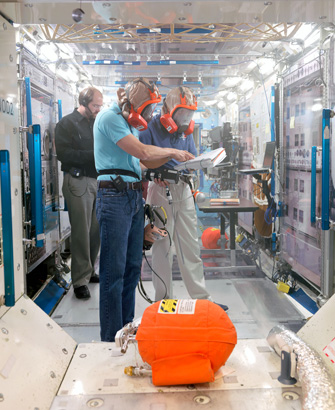
*Photo supplied by: JAXA/NASA

Hello everyone. This is Norishige Kanai.
Here in Houston, the comfortable weather season is over and the long, scorching hot summer is about to begin. The difference between the outdoor temperatures that are high enough to melt asphalt and the indoor temperatures with full-blast air-conditioning (especially in the simulation room which uses huge computers) is extreme and when I first arrived and started to live here, I was prone to getting sick but now I carry a thick jacket with me on hot days and my summer protection against the cold is perfect!
I visited Houston as part of the selection test to be an astronaut candidate four years ago (it was winter at the time). In comparison to that first visit, I feel that I am fairly used to it now in my own way.
After I had been chosen as an astronaut candidate and had got through around two years of candidate training, I was certified as an astronaut and now, as the first person up to bat for the 3 new JAXA astronauts, astronaut Yui is steadily continuing with his training for his first long term mission.
When we were selected in 2009, a new generation of astronauts was simultaneously selected not only from Japan but also from the US, Canada and Europe.
Even though our countries of origin are different, we are all astronauts who have received training at the same time which makes us new astronaut colleagues in the same intake.
The very first of the intake to arrive at the space station and begin his mission at the end of May was astronaut Parmitano from Italy. Without a pause, astronaut Hopkins (US) will be going in September, in 2014, it will be astronauts Wiseman (US) , Gerst (Germany) and Cristoforetti (Italy) and in 2015, it will be astronauts Yui (Japan), Lindgren (US) and Peake (Italy)… my other ‘classmates’ are going to successively take off into space and I am as excited and thrilled as if it were me!
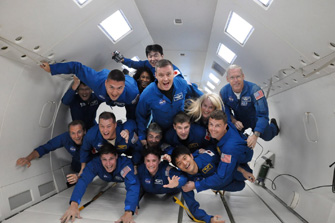
Everyone in the 2009 ASCAN (Astronaut Candidate) class with whom I have trained since 2009 ? we will all take off for space one after another. (Photo supplied by: JAXA/NASA)
Japanese readers will probably not know much about the astronauts apart from the Japanese ones but even for astronauts, the group that we have trained with and lived under the same roof with has something special. If you hear their names on the news or in information coming out of JAXA, please do give them (special) support!
So, when I talk about astronaut colleagues, this, of course, includes those who I have trained with but there are actually many more colleagues who I worked with to become an astronaut.
There were 963 applicants to the JAXA selection test through which Mr Yui, Mr Onishi and myself were selected and there were 48 participants in the second test where we all got to know each other a bit better and there were only 10 people at the final test that included a week’s enclosed environment test and interviews at NASA in Houston.
I am very aware of the fact that the people who took part in the exam and had a strong desire to be an astronaut were, at the same time, mutual rivals but also friends who shared the same dreams.
I haven’t done a detailed survey but compared to other countries, it seems that it is only Japan that has the unique characteristic of continued interaction between those who experienced the selection test years after the test is over.
I still get in touch with the people with whom I took the exam and we get together when I have the chance to go back to Japan and even though it was a few years ago, I vividly remember the sense of elation and tension at the time.
We forget about the time and get excited talking about when we were locked into the enclosed-environment facility at the Tsukuba Space Center together, when we all assembled in the hospital for intensive medical tests in the second test and when we took the written part of the first test and how nervous we were and so on.
What is surprising is that this is true not just for the class of 2008.
From the very first recruitment for Japanese astronauts when astronauts Mohri, Mukai and Doi were selected, the second recruitment when astronaut Wakata was selected, the third when astronaut Noguchi was selected to the fourth recruitment when astronauts Furukawa, Hoshide and Yamazaki were recruited, each generation of people who were selected are still in touch with each other.
The first Japanese astronaut to be selected was in 1985 so that means that this interaction has been going on for almost 30 years!
There are some people who have not given up on their dream and who have continued to take the selection test a number of times so the circle widens thanks to these people and there are some gatherings that go beyond the generations.
It is a slightly strange sight to see all the different people who have taken the test from those from the first recruitment who are already directors or managers in companies or university professors to those who took the test more recently and are working hard being the main driving force in their workplaces as well as energetic people who are going to take the test in the future such as engineers or researchers, where age and profession do not matter and where we all reminisce about the selection test and talk about our dreams of space flight. But at the same time, these gatherings are a platform where we can encourage each other and get the energy to keep on working hard.
There may not be many people in the general public who are interested in space development. However, when I am talking with these astronaut colleagues, I am once again convinced that this makes me burn with enthusiasm to achieve my dreams, that I can exhibit more competency than I thought I had and that I am in a wonderfully challenging field.
As a representative of these colleagues, I am grateful that the job of astronaut is to accumulate rare and valuable experiences everyday as well as making sure that as many people as possible know of the appeal and excitement of space development.
It’s only once a month but I think this column is a good place to introduce snippets of space development that will hopefully pique your interest. If you have any ideas about what kind of subjects would be interesting or what you think everyone would like to know, I would be really grateful if you would fill in the opinions/thoughts form underneath.










